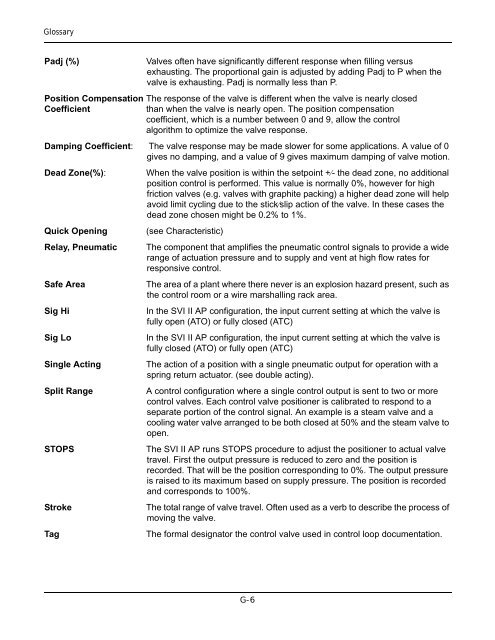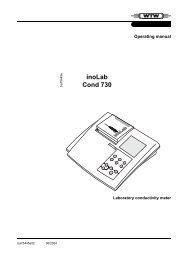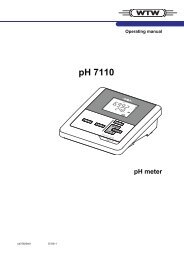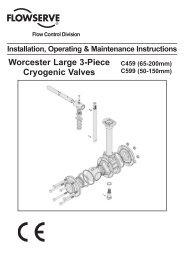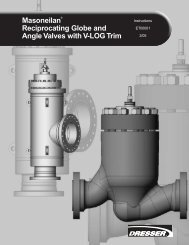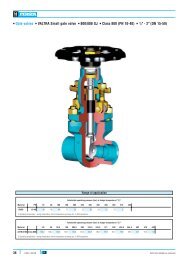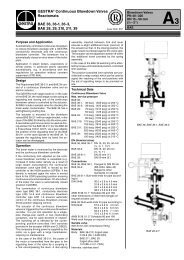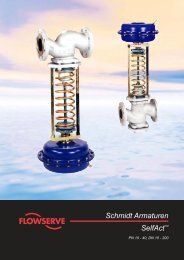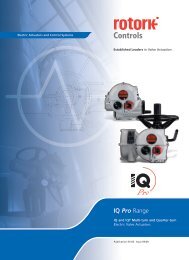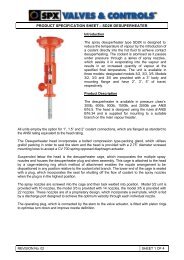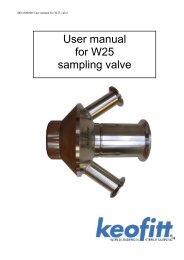SVI-II Instruc Man.book - Fagerberg
SVI-II Instruc Man.book - Fagerberg
SVI-II Instruc Man.book - Fagerberg
Create successful ePaper yourself
Turn your PDF publications into a flip-book with our unique Google optimized e-Paper software.
Glossary<br />
Padj (%)<br />
Valves often have significantly different response when filling versus<br />
exhausting. The proportional gain is adjusted by adding Padj to P when the<br />
valve is exhausting. Padj is normally less than P.<br />
Position Compensation The response of the valve is different when the valve is nearly closed<br />
Coefficient<br />
than when the valve is nearly open. The position compensation<br />
coefficient, which is a number between 0 and 9, allow the control<br />
algorithm to optimize the valve response.<br />
Damping Coefficient: The valve response may be made slower for some applications. A value of 0<br />
gives no damping, and a value of 9 gives maximum damping of valve motion.<br />
Dead Zone(%):<br />
Quick Opening<br />
Relay, Pneumatic<br />
Safe Area<br />
Sig Hi<br />
Sig Lo<br />
Single Acting<br />
Split Range<br />
STOPS<br />
Stroke<br />
Tag<br />
When the valve position is within the setpoint +⁄- the dead zone, no additional<br />
position control is performed. This value is normally 0%, however for high<br />
friction valves (e.g. valves with graphite packing) a higher dead zone will help<br />
avoid limit cycling due to the stick⁄slip action of the valve. In these cases the<br />
dead zone chosen might be 0.2% to 1%.<br />
(see Characteristic)<br />
The component that amplifies the pneumatic control signals to provide a wide<br />
range of actuation pressure and to supply and vent at high flow rates for<br />
responsive control.<br />
The area of a plant where there never is an explosion hazard present, such as<br />
the control room or a wire marshalling rack area.<br />
In the <strong>SVI</strong> <strong>II</strong> AP configuration, the input current setting at which the valve is<br />
fully open (ATO) or fully closed (ATC)<br />
In the <strong>SVI</strong> <strong>II</strong> AP configuration, the input current setting at which the valve is<br />
fully closed (ATO) or fully open (ATC)<br />
The action of a position with a single pneumatic output for operation with a<br />
spring return actuator. (see double acting).<br />
A control configuration where a single control output is sent to two or more<br />
control valves. Each control valve positioner is calibrated to respond to a<br />
separate portion of the control signal. An example is a steam valve and a<br />
cooling water valve arranged to be both closed at 50% and the steam valve to<br />
open.<br />
The <strong>SVI</strong> <strong>II</strong> AP runs STOPS procedure to adjust the positioner to actual valve<br />
travel. First the output pressure is reduced to zero and the position is<br />
recorded. That will be the position corresponding to 0%. The output pressure<br />
is raised to its maximum based on supply pressure. The position is recorded<br />
and corresponds to 100%.<br />
The total range of valve travel. Often used as a verb to describe the process of<br />
moving the valve.<br />
The formal designator the control valve used in control loop documentation.<br />
G-6


